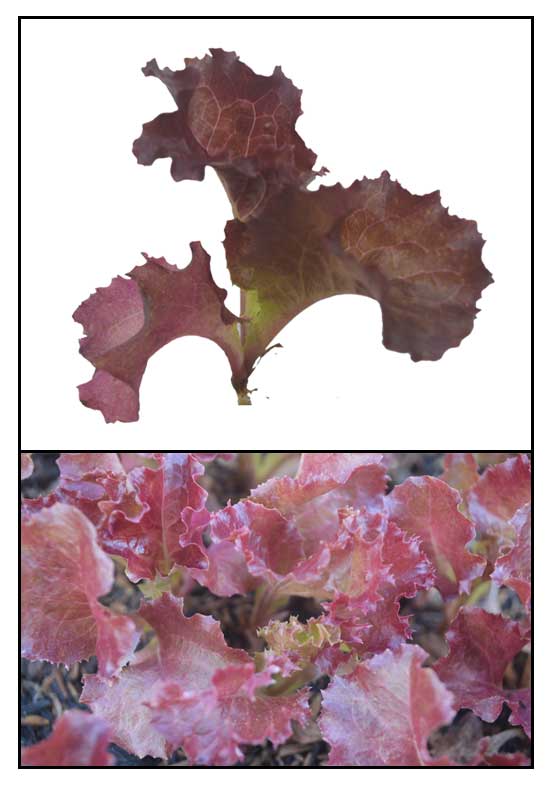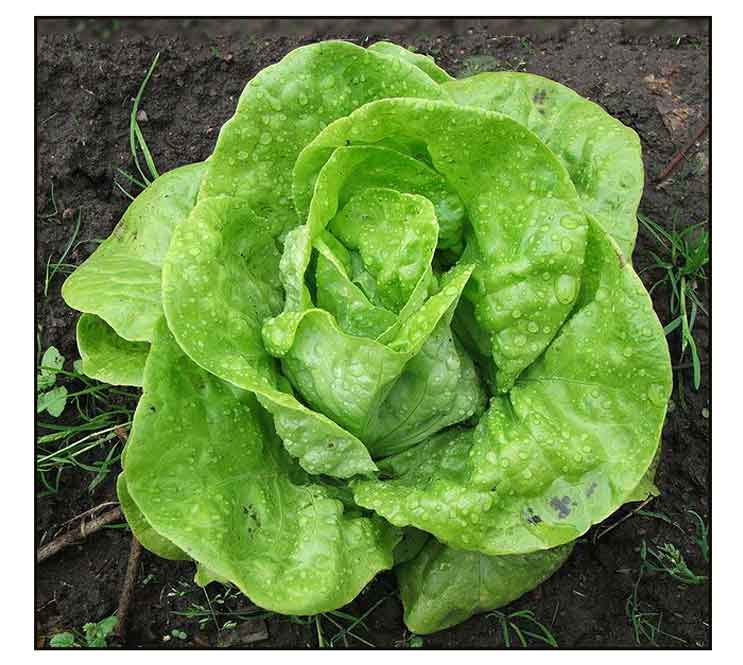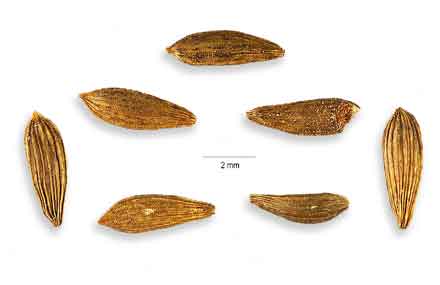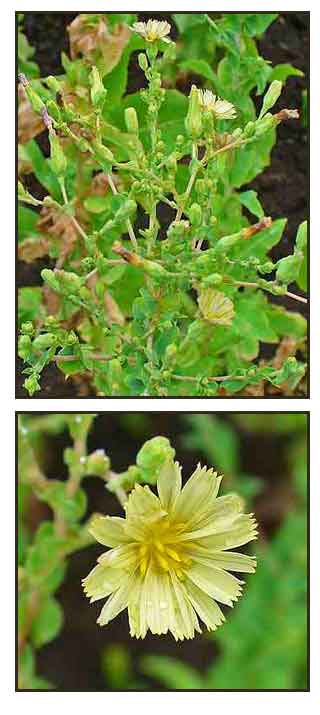 Gen info Gen info
- Lettuce (Lactuca sativa) is an annual plant in the family Asteraceae. It is often grown as a leaf vegetable, but sometimes for its stem and seeds.
- It was originally farmed by ancient Egyptians, later spreading to the Greeks and Romans, the latter giving it the name lactuca, from which the English lettuce is derived. (31)
-
Etymology: The genus name lactuca derives from Latin lac meaning "dairy" referring to the white latex exuded by cut stems. The species epithet sativa is Latin, meaning "sown" or "cultivated". Lettuce is Middle English, from Old French letues or laitues, derived from the Roman name. (31)
- Lettuce is the most common food linked with foodborne illness, including E. coli and Salmonella. Leafy greens have been linked with 22% of outbreaks of food poisoning in the past ten years. (On the bright side, poultry holds the distinction of causing the most deaths from food poisoning.) (32)
Botany
Letsugas is an erect, usually simple, annual, smooth, very leafy herb reaching a height of 1 meter when in flower. Leaves are stalkless, obovate to oblong-obovate, 6 to 20 centimeters long, entire or lobed, toothed, thin, and numerous at the base. Heads are numerous, about 1 centimeter long, and borne in open panicles; the branches, often much reduced, bear bractlike leaves. Flowers are yellow. Involucral bracts are ovate, the inner ones linear. Achenes are brown, with a very slender beak about as long as the body.
Distribution
- Introduced to the Philippines.
-
Common commercial and garden cultivation for food.
- Nowhere established.
 Constituents Constituents
- Leaves yield a bitter principle (lactucin),mannite, mallic acid, asparagin, and oxalic acid.
- The whole plant yields a volatile oil, vitamin A, and a trace of hyoscyamine.
- Latex contains d- and B-lectucerol, inosite, reducing sugar, and a bitter principle.
- Lacturacium or lettuce opium, mentioned in the old pharmacopoeias, is the milky juice of the plant.
- Phytochemical study of a methanol extract have yielded triterpenoids, saponins, and simple phenols.
- Yields antioxidants like quercetin, caffeic acid and vitamin C.
- Nutrient values of lettuce (cos or romaine, raw) per 100 g yield: (Proximates) water 94.61 g, energy 17 kcal, protein 1.23 g, total lipid (fat) 0.30 g, carbohydrate by difference 3.29 g, total dietary fiber 2.1 g, sugars 1.19 g; (Minerals) calcium 33 mg, iron 0.97 mg, magnesium 14 mg, phosphorus 30 mg, potassium 247 mg, sodium 8 mg, zinc 0.23 mg; (Vitamins) vitamin C 4.0 mg, thiamin 0.072 mg, riboflavin 0.067 mg, niacin 0.313 mg, vitamin B6 0.074 mg, DFE folate 136 µg, vitamin A 8710 IU, vitamin E (alpha-tocopherol) 0.13 mg, vitamin K (phylloquinone) 102.5 µg; (Lipids) total saturated fatty acids 0.039 g, total monosaturated FA 0.012 g, total polyunsaturated FA 0.160 g, cholesterol 0. (19)
- Chemical compounds that occur in lettuce: α-lactucerol (taraxerol), ß-lactucerol (lactucon, lactucerin), lactucin, and lactucopicrin.
- Study of hydroalcoholic extract by HPLC for polyphenols yielded the presence of chlorogenic acid, vanillin, epicatechin, caffeic acid, rutin hydrate, sinapic acid, quercetin-3-rhamnoside, p-coumeric acid, and quercitin. (see study below) (20) (for comparison with red leaf lettuce, see link: 30)
- Study isolate
a new flavonol glycoside, lactucsativoside A from the seeds, together with three known compounds, japonicin A (2), isoquercitrin(3), and caffeic acid (4). (23)
 Properties Properties
- Cooling and refreshing.
- Anodyne, purgative, diuretic, diaphoretic, antispasmodic, mildly soporific and hypnotic.
- The ancients considered it an aphrodisiac.
- Fresh plant extract considered a milk sedative.
- Seeds are aromatic and bitter.
- Studies have suggest antioxidant, analgesic, anti-inflammatory, neuroprotective, anti-spermatogenic, anti-leukemic properties.
Parts used
Juice, leaves, seeds.
Uses
Edibility / Nutrition
- Excellent source of vitamins A and C; a good source of vitamin B, carotene, and vitamin E.
- Early leaves, eaten as salad, are easily digested, but yields a poor amount of nutritive matter.
- Used in soups, sandwiches, and wraps; eaten raw or cooked.
Folkloric
- Flowering plant produces, in feeble degree, the effects of lacturacium.
- Juice used as substitute for opium.
- Lettuce opium has been used in folk medicine to aid circulation in treatment of swollen genitals. In Europe it is used as a substitute of opium in cough mixtures. In homeopathy, tinctures have been used in laryngitis, bronchitis, asthma, coughing, and UTIs. In Chinese medicine, dried juice has been used as topical wound antiseptic; seeds have been used as galactagogue.
(36)
- Extract from fresh plant is a mild sedative; also, useful in the treatment of coughs in phthisis, bronchitis, asthma, and pertusis.
- In ancient folk medicine, used as appetite stimulant and aid to sleep.
- Lettuce poultice used as soothing application to painful and irritable ulcers.
- Infusion of seeds given in fevers, especially typhoid.
- Seeds also given for excessive thirst and to provide a sensation of heat in the stomach.
- Decoction of seeds used as demulcent; also as sedative and for treatment of insomnia.
- Believed to relax the genitalia and diminish spermatic secretion.
- Seeds, boiled or made into confection, useful for chronic bronchitis.
- In Iran, seeds are use for relieving inflammation and osteodynia.
Others
- Lettuce opium: Lettuce opium products have been marketed as legal highs or narcotic substitutes intended to be smoked alone or in combination with marijuana to enhance potency or flavor. (36)
 Studies Studies
• Analgesic / Anti-Inflammatory: Study of crude methanol/petroleum ether extract of seeds showed time- and dose-dependent analgesic effect in formalin test and a dose-dependent anti-inflammatory activity in a carrageenan model of inflammation. (1)
• Antioxidant / Protection Against D-Galactose Induced Oxidative Stress: Study showed L. sativa protected neurons from accumulation of lipofuscin granules, proving itself an effective antioxidant. (Lipofuscin or age pigment is a yellowish-brown autofluorescent, protein and lipid containing pigment that accumulates in the lysosomes of a variety of post mitotic cells including neurons and cardiac myocytes during ageing.) Results showed L. sativa protects against D galactose-induced oxidative stress and reduces accumulation of lipofuscin granules. (2)
• Antioxidant: Study of methanolic extract of leaf showed significant antioxidant potential both in vitro and in vivo. (8)
• Anti-Inflammatory: Study isolated bioactive anti-inflammatory compounds: 3,14-Dihydroxy-
11,13-dihydrocostunolide and 8-Tigloyl-15-Deoxyl-actucin. Both showed substantial lipooxygenase inhibitory activity and significant in-vivo anti-inflammatory activity on a carrageenan-induced paw edema model. (3)
• Polyphenols / Greenhouse vs Open-air: Study of lettuce extracts showed higher flavonol contents in open-air samples than the greenhouse ones. (4)
• Antinociceptive / Opioid Pathway: Study showed a remarkable nociceptive effect. An opioid pathway is a possible mechanism. (6)
• Neuroprotective: Study evaluated the capability of L. sativa in protecting neurons against glucose/serum deprivation (GSD)-induced cell injury, an in vitro model of brain ischemia. Results showed an intermediate polarity fraction of L. sativa exhibited neuroprotection and presents a potential therapeutic strategy for common neurodegenerative disorders such as stroke. (9)
• Antioxidants / Fresh Vs Stored Lettuce: Study evaluated whether storage under modified-atmosphere packaging affected the antioxidant properties of fresh lettuce. Results showed no changes after ingestion of MAP-stored lettuce in all markers. MAP-stored lettuce did not modify plasma redox status in healthy subjects. (10)
• Case of Hypersensitivity to Lettuce: A report of clinical sensitization to lettuce was reported with mucocutaneous manifestations. CAP inhibition showed antigenic community between lettuce and mugwort. Four protein bands from the lettuce extracts exhibiting IgE-binding properties. (11)
• Anti-Spermatogenic Effects / Seeds: Study of hydroalcoholic and aqueous extracts of lettuce seed showed anti-spermatogenic effects. The aqueous extract increase serum testosterone level in mice. Results suggest the lettuce seed has potential as a contraceptive agent. (12)
• Potentiating Effect on Pentobarbital-Induced Sleep: Study evaluated the sleep-prolonging effect of the plant in mice. Results showed lettuce potentiates pentobarbital hypnosis without major toxic effect. The responsible component is most likely non-polar agent)s) found in the n-butanol fraction. (13)
• Functional Food Properties: Study compared the functional food properties of selected commercial red and green lettuce. Both had strong antioxidant and anti-inflammatory properties. However, anthocyanin in red lettuce is an additional source of biological activity. The variation in phenolic contents and the lack of anthocyanins in green lettuce gives red lettuce a higher biological activity. (14)
• Safety and Effect of Seed Oil in Sleep Disorders: Study evaluated capsules of L. sativa seed oil in 60 patients suffering from insomnia. Improvements in the modified State-Trait Anxiety Inventory and Sleep rating scale scores were significantly greater in patients receiving seed oil. No side effects were attributable to the seed oil at the test dosage. (15)
• Protective Effects on CCl4-Induced Reproductive Toxicity: Study evaluated the protective effects of ethanolic extract of lettuce leaves against toxicity caused by carbon tetrachloride in reproductive system of rats. Results showed the extract augments the antioxidant defense mechanisms against CCl4-induced toxicity and suggests a potential therapeutic role in free radical mediated diseases. (16)
• Anti-Leukemic Effects: A water extract of lettuce Lactuca sativa inhibited the growth of HL-60 leukemic cells and MCF-7 breast cancer cells, correlating with the activation of Chk2, the induction of tumour suppressor p21, and the severe down-regulation of the proto-oncogene cyclin D1. The ethyl acetate extract induced HL-60 cell death, correlating with the acetylation of α-tubulin. (17)
• Anxiolytic / Polyphenols: Study evaluated the anxiolytic property of hydroalcoholic extract in two animal models viz. Elevated T maze and hyponeophagia, with diazepam as standard. Results showed potent anxiolytic activity attributed to the extract rich in polyphenols and secondary metabolites. (see constituents above) (20) Study evaluated the effects of a hydroalcoholic extract of lettuce on rats behavior in the elevated plus-maze (EPM) method. Acute administration of lettuce extract showed an anxiolytic profile in rats similar to that of diazepam at low dose. (29) Study evaluated a hydroalcoholic extract of leaves of L. sativa on mice models for anti-anxiety properties using open field test (OFT), elevated plus maze test (EPM), elevated T maze test, and marble burying test. Increased locomotor activity and time spent in "open arm" test were observed in the extract treated group, along with decreased MDA and nitrite level, and increased catalase and glutathione levels. Results suggest L. sativa has potent anxiolytic activity. However, responsible components were unclear. (33)
• Comparative Antioxidant Properties of Five Varieties / Red Coral: Study determined the total antioxidant and antioxidant activities of five varieties viz. iceberg, butterhead, romaine, green coral and red coral. EC50 on DPPH radical scavenging assay ranged from 303.56 to 4485.41 µg/ml. Red coral lettuce had the lowest EC50 which indicates the highest antioxidant activity among the varieties. Red coral lettuce also showed the highest value of total phenolic content (range 4.85 to 76.05 mg gallic acid equivalent/100 g fresh weight). EC50 on DPPH and FRAP highly correlated with total phenolic content and total flavonoid content. (21)
• Alkylperoxyl Radical Scavenging of Phenolics / Red Lettuce: Phenolic compounds from red leaf lettuce tissue extracts were mono- and dicaffeoyltartaric acid (CTA and DCTA), mon- and diacaffeoylquinic acid (CQA and DCQA), quercetin 3-malonylglucoside (QMG), quercetin 3-glucoside (QG), cyanidin 3- malonylglucoside (CMG) and an unknown phenolic ester (UPE). The decreasing order of specific peroxyl radical scavenging activities was CMG>QG>DCTA>DCQA>QMG>UPE>CQA>CTA. Since plant flavonoid and phenolic esters are sensitive to environmental factors, this information is important for pre- and post-harvest conditions which may increase the dietary benefits of leaf lettuce. (22)
• Analgesic / Anti-Inflammatory / Anti-Depressant / Anticoagulant / Seed and Leaf: Study of a MC (methanol and chloroform, 1:1) and aqueous extracts of seed and leaf and cell suspension exudate showed multiple pharmaceutical effects viz. analgesic and anti-inflammatory activities, anti-depressant effect on the CNS, and a strong anticoagulant effect. No abnormal behavior or lethality was observed in any animal tested. (25)
• Effect on Arterial Blood Pressure and Heart Rate: Study evaluated the effects of a hydroalcoholic extract of Lactuca sativa on blood pressure in rats with hypertension induced by desoxycorticosterone (DOCA)-Salt. Results showed a significant decrease of MAP (mean arterial blood pressure), along with increased level of PRA (plasma renin activity) and urine volume. There was no significant effect on HR. (26)
• Lactucaxanthin / Potential Anti-Diabetic Carotenoid: Study hypothesized that lactucaxanthin (Lxn) in lettuce inhibits the activity of α -amylase and α -glucosidase. Study evaluated the interaction of Lxn with α -amylase and α -glucosidase in silico and its effect on the enzymes. Results showed significant inhibition of both enzymes with potential medical and nutritional relevance in the treatment of diabetes. (27)
• Effect on Spermatogenesis and Sexual Hormones / Leaves: Study evaluated the effect of lettuce leaf extract on some reproductive traits such as testes weight and primary spermatocyte testosterone, LH, and FSH in mice. Results showed a negative effect on male mice reproductive physiology as evidenced by significant reduction of secondary spermatocytes and concentrations of testosterone, LH, and FSH. (28)
• Sleep-Inducing Effect of Lettuce Varieties: Traditionally, lettuce has been suggested to have a sedative-hypnotic property. Study evaluated the sleep-inducing effect of lettuce varieties and extracts derived from romaine lettuce on pentobarbital-induced sleep. Romaine lettuce showed higher lactucin content (red romaine 361.50 µg/g extract; green 1071.67 µg/g) compared to green and red lettuce varieties. Seed and leaf extracts from romaine lettuce induced an increase in sleep duration at low and high doses, respectively. Seeds of romaine lettuce showed higher content of polyphenols, including caftaric acid, chlorogenic acid, and chicoric acid, compared to the leaf extract. Romaine lettuce is an valuable source of sleep potentiating material and contains antioxidant phenolics that protect from oxidant stress caused by sleep disturbance. (34)
• Effect of Topical Seed Oil on Childhood Sleep Disorders / Clinical Trial: Double-blind randomized controlled trial in 3-6 year-old children with sleep disorders evaluated the effect of either topical placebo oil and clonidine capsule or lettuce seed oil and placebo capsule for three weeks. Lettuce oil was prepared using cold press method. Sixty-seven out of 72 completed the study. Children in the intervention group significantly improved regarding bedtime issues (p<0.001), excessive daytime sleepiness (p=0.003), night awakenings (p=0.008) and problems in regularity and duration of sleep (p<0.001). Results suggest topical use of lettuce seed oil on the forehead and temporal areas could be considered a safe and effective treatment for sleep disorders. Further studies with larger sample size, longer follow-up duration were suggested. (35)
• Lettuce Opium / Seeds: Lettuce opium has been used as topical antiseptic, as folk medicine to ameliorate a variety of conditions, as a narcotic substitute or enhancer, as mild sedative and hypnotic. Doses of 1,000 mg of lettuce seed have been used for periods of up to 2 weeks in a small double-blind randomized placebo-controlled trial. (36)
• Effect of Lettuce Seed Oil on Insomnia in Pregnant Women / Clinical Trial: A prospective randomized clinical trial of 100 women with insomnia aged 20-45 years were assigned capsules containing 1000 mg of lettuce seed or placebo daily for two weeks. Results suggest that lettuce seed decreased insomnia during pregnancy and could be recommended as a safe natural remedy for treatment of pregnancy-related insomnia. (37)
• Lettuce Opium / Lactucarium: Lettuce opium was used by the ancient Egyptians, and introduced as a drug in the United States about 1799. It was considered an alternative to opium, although weaker and not highly addictive. In 1898 it was standardized in the United States Pharmacopoeia for use in lozenges, tinctures, and syrups as sedative for irritable cough or as mild hypnotic for insomnia. Lactucin is a major active compound in lactucarium, which is found in higher concentrations in green romaine lettuce than in red varieties (1071.67 µg/g and 361.50 µg/g, respectively). Lactucarium use has waxed and waned. It is still occasionally promoted as a legal psychotropic. The seed of ordinary lettuce Lactuca sativa is still part of various folk medicinal pharmacopoeias. (38)
• Alternative Procoagulant for Blood Analytes: Study evaluated the effectiveness of Lactuca sativa as pro-coagulant on blood analytes to hasten the coagulation of blood prior to testing. L. sativa extract hastened the coagulation of blood with the smallest extract dose (25µL) that rendered the fastest clotting time. Results suggest L. sativa possess pro-coagulant activity with potential use in the testing of FBS, cholesterol, triglycerides, LDL, HDL and uric acid. (39)
Availability
- Cultivated.
- Seeds in the cybermarket.
|

![]()



 Gen info
Gen info
 Properties
Properties
